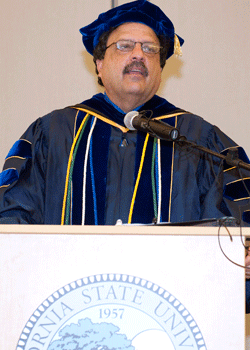Provost honors faculty contributions to CSUEB at honors convocation

CSUEB provost James Houpis in academic robe and hood
- February 28, 2011 5:30pm
James Houpis, provost and vice president of Academic Affairs, addressed those in attendance at Faculty Honors Convocation on Thursday, Feb. 24. See his remarks below.
Today we recognize faculty that have reached a historical point in their career. We honor these faculty because they have achieved success, yet at opposite ends of their career.
We recognize those who have completed 25 years of service to our students, our University; and our community. Through the good years and the bad, they have never given up on the importance of access to public higher education. To those who have attained emeritus status, we are recognizing you not just because you are retiring; rather we confer this honorary title to you for your long and distinguished service to this institution. With the title of Professor emeritus and the privileges it provides, I am hopeful you will continue your scholarship, and service to our students and our community.
And for our newly tenured faculty, congratulations — and now the real fun begins. Our tenured professors are faced with increasing scholarly requirements and service to our community. It is important for our newly tenured faculty to recognize that the professorate is always evolving, and things we take for granted, are not always so. According to Philip Altbach, there have been 10 distinct identifiable generations of higher education. The three of the last 4 generations play a particular importance to where we are as an academe today.
If you will allow me, Generation 7: Growth and Standardization occurred from 1890- to WWI. During this period, we saw the beginning of the rise of women participating in higher education. Also, universities became compartmentalized, which unfortunately has led to our present academic silos. But of great importance was the concept of academic freedom, which the American Association of University Professors began to champion as early as 1915.
Generation 9: The Academic Revolution occurred between 1945-1975. Two important events occurred during this period of time. The first was the G.I. Bill, which resulted in a surge in attendance in institutions of higher education, and the mandate for workforce development. During this period, the CSU saw a rapid expansion of its campuses, including the establishment of CSU East Bay. And for those of you that just received tenure, tenure has not always been around. It was in 1940, that the AAUP recommended that the academic tenure probationary period be seven years. It also suggested that a tenured professor could not be dismissed without adequate cause, except "under extraordinary circumstances”. However, it wasn’t until 1945 when the effects of the GI Bill provided the impetus for a significant adoption of the principle of tenure by institutions.
We are now living in Generation 10: Regulation, Relevance and Steady State. It is surely characterized as is a time of uncertainty, and a search for a steady state. It is a time, many view, as an opportunity to reshape higher education, and define, instill and support our basic mission; we are a public institution in service for the public good. So for my newly tenured colleagues, with the decades that lay in front of you, I encourage you to be engaged and participate in defining this generation — the shape of higher education in the 21st century, where out dated practice will be replaced with innovative best practices, where our new students will continue to be served with excellence in learning, along with our expanding role in community service, scholarship, and research. Our region, our state, and our country will depend on leadership from you and Academia. Thank you.
BZ